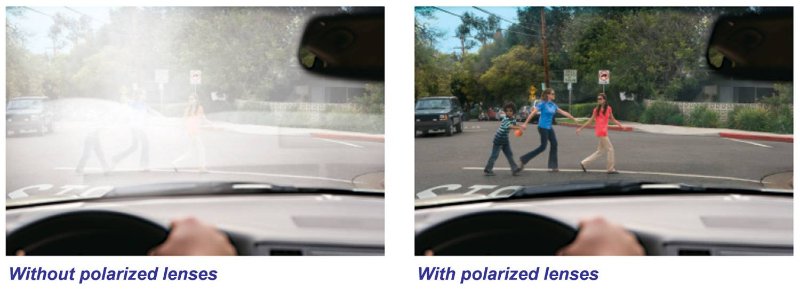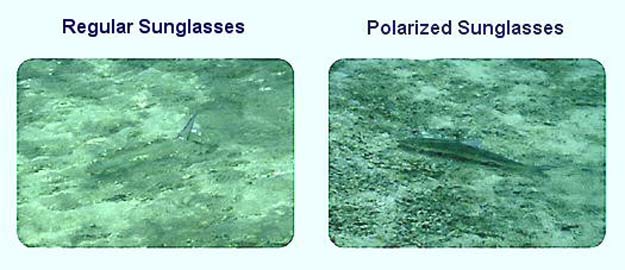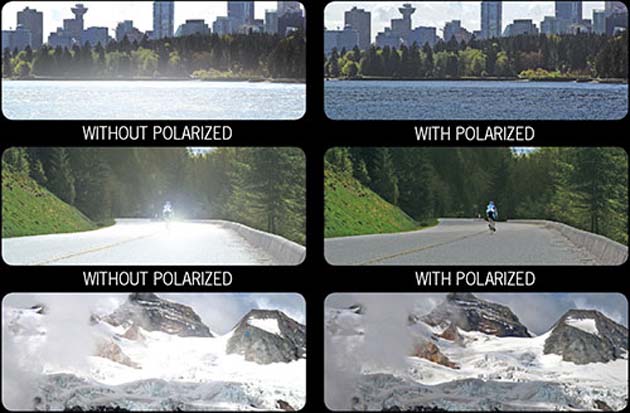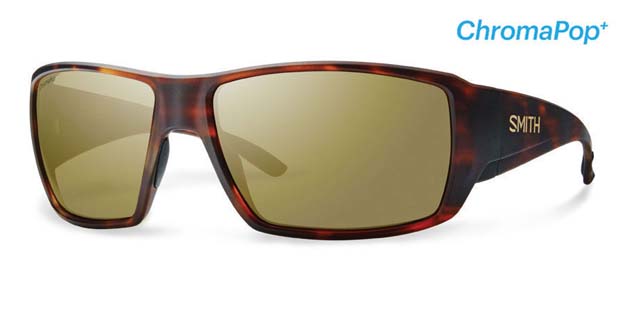The insidious nature of glare
by Skip Clement
Polarized lenses can enhance visual acuity, color contrast and visual comfort, and block 100% of harmful UVA and UVB light.

Costa Del Mar Fantail in Realtree Camo with Blue Mirror 580P Lenses
[dropcap]T[/dropcap]exting while driving kills and so does glare. Glare, unlike texting while driving, is an involuntary occurrence that has no prejudice for driver or vehicle. Glare bounces off the roadway, off the car hood, off other vehicles, off glass buildings, even off the dashboard, and off the sand at the beach, and especially off the surface of the water.
Glare at its least has impact that is annoying, but when the angle of reflection is just right, the glare can become blinding and deadly (think driving a vehicle or piloting a boat).
 What won’t help?
What won’t help?
Ordinary tinted sunglass lenses only cut down on ambient light that reaches the eye, or, light transmittance. Tinted, rack bought sunglasses cannot block glare. Only polarized lenses can block out glare. There are gradations of function with polarized glasses – beware of dirt cheap.
So, how does glare work and how do polarizing lenses work?
When light bounces off of a surface, its light waves travel in all directions: some light travels in horizontal waves, while others travel in vertical waves. When light hits a surface, typically light waves are absorbed and/or reflected in a random manner. However, if light hits a reflective surface like water, snow, vehicles or even buildings at just the right angle, some of the light becomes “polarized.”
 What does that mean?
What does that mean?
It means that vertical light waves are absorbed while horizontal light waves bounce off the surface. This light can become polarized, resulting in glare that can interfere with your vision by striking the viewer’s eyes intensely. Only polarized lenses can remove this glare.
What, then, is a polarized lens?
Polarized lenses are laminated with tiny vertical stripes that only allow vertically angled light to enter the wearer’s eyes. Glare is eliminated because the horizontal light waves cannot bypass the vertical filter. Sunglasses and camera lenses are often polarized to reduce glare from surfaces.
How do polarized lenses work?
When light bounces off of a surface, its waves tend to be strongest (usually) horizontally, vertically, or diagonally. This is called polarization. Polarized lenses contain millions of parallel rows of tiny iodine crystals or dichroic dyes (so small they can’t be seen with the naked eye).
Like venetian blinds, the horizontal rows of iodine crystals contained within the polarized lens block out horizontal polarized light waves, letting only (non-polarized) vertical light waves reach the eye. Polarization blocks as much as 50% of the light passing through a lens. The person looking through the lens can still see clearly (in most cases), but it reduces the brightness and glare of light. The result, of course, is no glare vision because only a polarized lens can block glare.
Types of polarized glasses and lenses, buyer beware
Lenses can be polarized to varying degrees and in different ways. The most inexpensive polarized sunglasses have only a thin film applied on one side of the lens. Better polarized lenses have film laminated between two layers of lens material, preventing it from being scratched or rubbed off – the more dense the film is, the more polarization it provides.
 Telling the difference
Telling the difference
Generally speaking, polarized sunglasses don’t look any different from regular sunglasses. While denser films tend to be darker, the color of a lens does not determine how much polarization it provides. A very dark pair of sunglasses with a light film will not block more glare than a lighter shade of glasses with a denser film. The color of the lens is also variable (they cannot be made clear), polarized lenses can be made in gray, brown, green, or other colors, which have advantages under different sunlight conditions
Different polarized lens options
Polarized lenses are available in nearly all lens types, materials, coatings and designs, such as polarized varifocal lenses or polarized high index lenses and many more combinations.
Polarized lens advantages
Reducing glare can ease the eye strain drivers feel from long hours on the road. Fishermen can often see under the surface of water using the lenses, which helps them to see fish or other objects. Photographers use polarizing filters on camera lenses to enrich the images they capture by giving them more contrast, and to increase the range of effects they can produce.
In addition to blocking blinding glare, polarized lenses can also help you to see better by improving contrast and visual comfort and acuity.
Polarized lens limitations
Because the polarizing stripes reduce the amount of light entering the eye, these lenses should not be used at night or in other situations where clear lenses are required. Polarized lenses can cause distortions in the way wearers see liquid crystal displays (LCDs), rendering some cell phone screens, clocks, and other displays unreadable. Pilots should not use polarized glasses because they can make flight instruments difficult to read and other objects in the sky – including other airplanes – less visible.

Trending at a dock near you. Smith Optics’ Chroma Pop polarized glasses.
Choosing lens color
Green: Good for general purpose use, offers even color perception, dims glare while brightening shadows, and provides good contrast for low-light conditions.
Brown/Copper: Good for variable everyday conditions, enhances contrast, and contains a red element to improve depth perception. These are the “go to” colors for most flats fisherman.
Yellow/Amber: Provides greater clarity in fog, haze, and other low-light conditions and filters out blue light from computer screens and other electronic devices that can cause eye fatigue and headaches. Low light flats fishing is a good time to wear these lenses.
Blue/Purple: Trendy and aesthetically pleasing, reduces glare, helps define contours, and enhances color perception.
Gray/Black: Good for general purpose use, reduces eye fatigue, provides true color perception, minimizes glare, especially off water, and darkest tint with highest available light reduction. Popular for bluewater fishing.
Pink/Red: Improves visual depth, reduces eye strain, provides good road visibility, and offers greatest amount of contrast.
Green and Gray/Black offer the most field condition benefits, but for shear simplicity Amber/Brown works just fine for fishing both sunny and partly cloudy days – conditions most anglers are likely to experience. And that includes contrast and depth perception. Both combinations usually come with prescription options. Some colors/tints are not prescription available. Be sure to inquire about that.
Sources: UK Opticians, Opticians Association of America, All About Vision, Frames Direct, past articles from Fly Fisherman, Fly Rod & Reel, Field & Stream, and Outdoor Life.
Featured Image: Capt. Andrew Derr with Costa Del Mar polarized sunglasses.
Some popular polarized glasses resources
Smith Optics, Costa Del Mar, Maui Jim, Oakley, Ray-Ban, Solar Bat, Hobie Polarized







